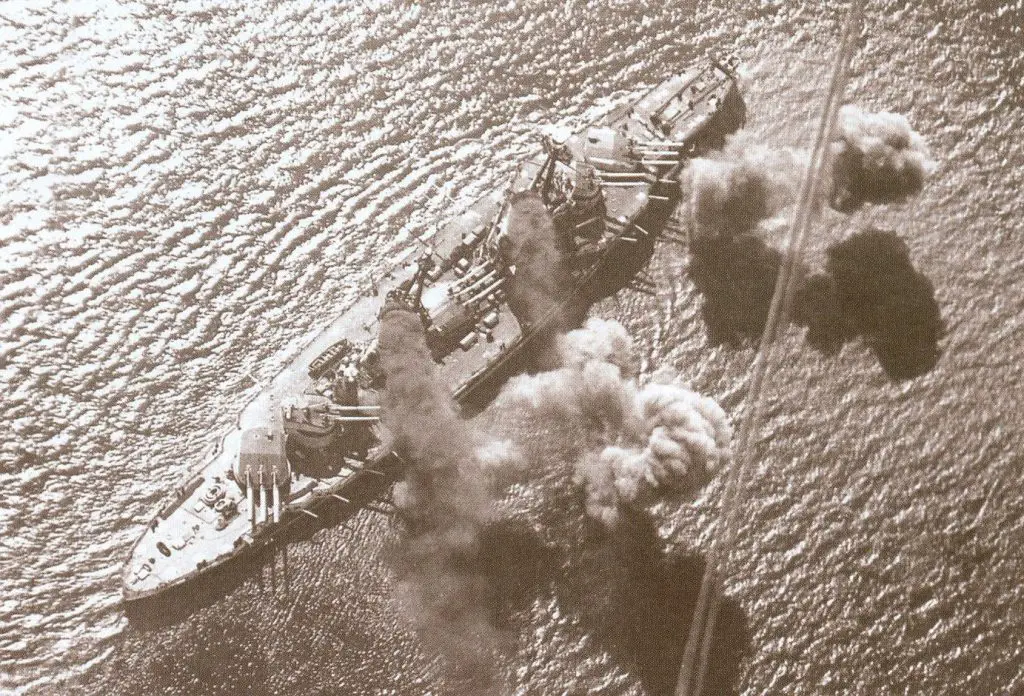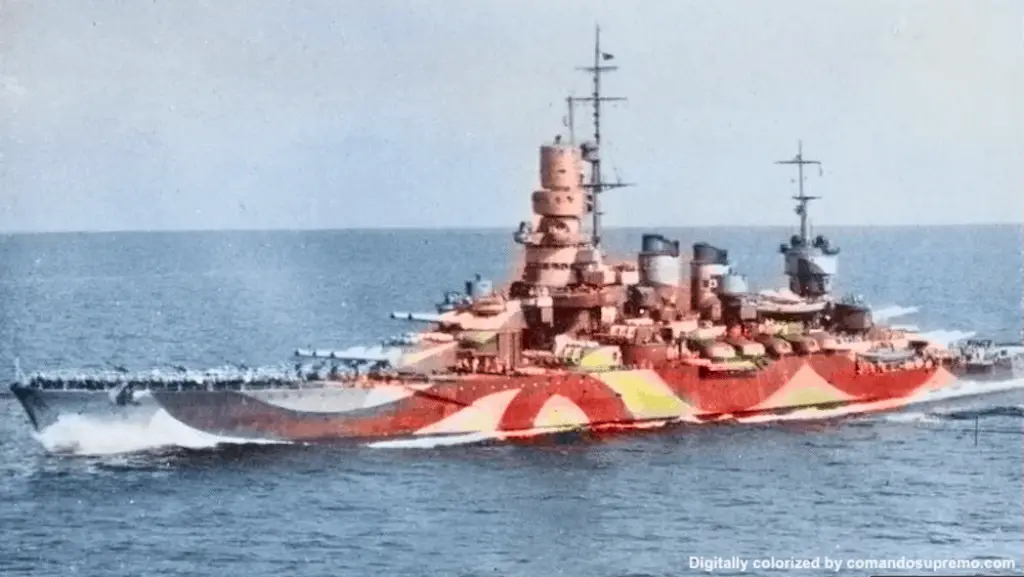Background On The Andrea Doria Class Battleships
Construction on the Andrea Doria Class battleships started in 1912, Caio Duilio beginning on February 24th. Construction of Andrea Doria began a month later, on March 24th. Caio Duilio joined active service in May of 1915, while Andrea Doria followed suit in March of 1916. In the years since some ambiguity has come to exist as to the proper name of the class. It’s called both the Caio Duilio and the Andrea Doria Class, and neither is essentially incorrect.

The construction of new battleships elsewhere prompted the order of the Andrea Doria Class. In particular, Supermarina sought a counter to the new Bretagne battleships under construction in France. As the Conte di Cavour class was found satisfactory, the design of Andrea Doria was intended as an incremental improvement. The Cavour Class boasted impressive specifications for the day, so marginal improvement on an effective design seemed sensible.
| Ship | Builder | Laid Down | Launched | Completed |
|---|---|---|---|---|
| Andrea Doria | La Spezia Arsenale, La Spezia | 24 March 1912 | 30 March 1913 | 13 March 1916 |
| Caio Duilio | Regio Cantiere di Castellammare di Stabia, Castellammare di Stabia | 24 February 1912 | 24 April 1913 | 10 May 1915 |
Conservative Use
In the narrow waters of the Adriatic, the Austrians and French lost battleships. Not in grand battles, but to raids by torpedo boats and submarines. Seeing this, the Italian naval chief of staff, Paolo Thaon di Revel, adopted a conservative strategy. As a result, the Andrea Doria Class battleships avoided battle until the Second World War. They enjoyed an active career in the interwar years, participating in international incidents at Fiume, Izmir, and Corfu. Prior to the Second World War, they received extensive upgrades to put them on par with more modern battleships. Therefore, they went on to serve in the convoy battles of the Mediterranean Theater. Both ships survived the war and would remain with the Marine Militaire of the Italian Republic in the aftermath.
Original Design
As the Conte di Cavour class was generally found satisfactory, the Andrea Doria Class battleships reused their basic design. The two classes had an identical speed of 21 knots, owing to a shared 30,000shp engine. They had an identical, relatively short range of 4,800 nautical miles, which was suitable for the Mediterranean. At a deep load, her displacement was 25,126 tons; a figure marginally lighter than Cavour. Andrea Doria measured 176m long, 28m by the beam, and possessed a draught of 9.4 m. On the ocean, the 1,233 sailors found their home onboard. In terms of the basic frame, the only alteration was the minor reduction of the superstructure.
Armament
Andrea Doria retained the thirteen 305 mm guns and 3×3 plus 2×2 layout, with a battery amidships. However, the superstructure limited the firing arc of the amidships battery. Therefore, Andrea Doria could only fire five of thirteen guns forward or backward. She retained the three, 450 mm torpedo tubes, although torpedoes on battleships weren’t very practical. They realized this during the war, and the eventual reconstruction involved removal of the torpedo tubes.

The Caio Duilio aft 12 inch gun turrets. The Caio Duilio is an Andrea Doria class battleship.
One of the major upgrades received by Andrea Doria improved her secondary armament. The 120 mm guns of the Cavour battleships had their place taken by sixteen 152 mm guns in single mounts. Besides that, Andrea Doria possessed nineteen light, 76 mm guns, also in single mounts. She had no AA protection at first, although she received a pair of machine guns by the end of the war.
The armor of the Andrea Doria battleships was broadly similar to the Cavour class, with their main armor belt measuring 250 mm. Gun protection amounted to 280 mm-240 mm turrets and 130 mm barbettes, while the conning towers possessed 180 mm-280 mm of armor. Deck armor consisted of 98 mm of steel, a major improvement to the 40 mm deck armor of the Cavour Class.
Peacetime Activity And Reconstruction
After the war, the Andrea Doria class battleships played a role in suppressing nationalist rebels during the Fiume Incident. Additionally, they would bombard Greek forces on Corfu after an international incident in 1923. Caio Duilio temporarily went into reserve in 1925, after a magazine explosion wrecked one of the turrets. Her repairs completed in 1928, and she reentered active duty. While suitable for minor actions, the ships grew increasingly long in the tooth. To prepare them for future conflict, they entered drydock in 1937 for extensive modernization.
A new 75,000shp engine replaced the old, 30,000shp engine. As a result, the already respectable speed of the ships grew to 26-27 knots. Additionally, Supermarina ordered the removal of the center turret and torpedo tubes. The high-velocity 320 mm guns took the place of the remaining 305 mm guns and a reduction of the anti-ship secondary armament occurred. Furthermore, four 135 mm guns and ten dual purpose 90 mm guns replaced the plentiful 120 mm guns of the original design. The freed space became host to a sizeable antiair defense of 37 mm and 20 mm guns, 31 in total. The secondary turrets gained provided 120mm of armor protection, and the deck armor increased to 135 mm. Additionally, the Andrea Doria Class battleships received a smaller version of the Pugliese torpedo defense system. As a result, the modifications increased displacement to 29,863 long tons.
Service History in the Second World War And Beyond
Both vessels were undergoing reconstruction at the start of Italy’s involvement in World War Two.
The Andrea Doria class saw light service in the war, especially as Caio Duilio needed to see repairs after the attack at Taranto. The state-of-the-art Littorio received priority, further slowing the repairs of Duilio. However, the other victim of the Taranto raid, Conte di Cavour, never completed its repair. While employed in the convoy battles of 1940-1942 such as First Battle of Sirte, they suffered increasing handicaps by 1942. Inadequate fuel stocks and a shrinking complement of light ships placed continuously growing restraints on operations. It was so severe that in 1942, Caio Duilio joined inactive units in reserve, her fuel drained to provide for escorts.

A birds-eye view of the Andrea Doria firing her main guns.
In the next year, Italy surrendered, and both Andrea Doria Class battleships sailed to Malta to surrender to the Allies. Unlike Roma, sunk by a German bomb, both ships reached internment at Malta in one piece. While the other battleships become prizes to the victorious allies, Italy retained both Dorias. They would alternate as fleet flagship until 1953 and their removal from active service. By 1956, the Marine Militaire struck them from the naval registry and sold them for scrap in the years after.

A digitally colorized photo of the camouflage pattern of the Andrea Doria Battleship as she sails to Malta in September 1943.
Specifications
| Class | Andrea Doria |
|---|---|
| Type | Battleship |
| Built | 1912-1916 |
| Displacement | 29,863 long tons |
| Length | 577 ft 5 in (176 m) |
| Beam | 91 ft 10 in (28 m) |
| Propulsion | 30,000 shp (22,000 kW) 20 × Yarrow boilers |
| Speed | 26 knots |
| Range | 4,800 nm at 10 knots |
| Crew | 1,233 |
| Armament | 3×3 + 2×2 305 mm (12") guns (3) 450 mm torpedo tubes (16) 152 mm (6") guns (19) 76 mm (3") guns |
| Armor | Belt: 250 mm Gun turrets: 280 mm Casemates: 130 mm Deck: 98 mm Conning tower: 280 mm |